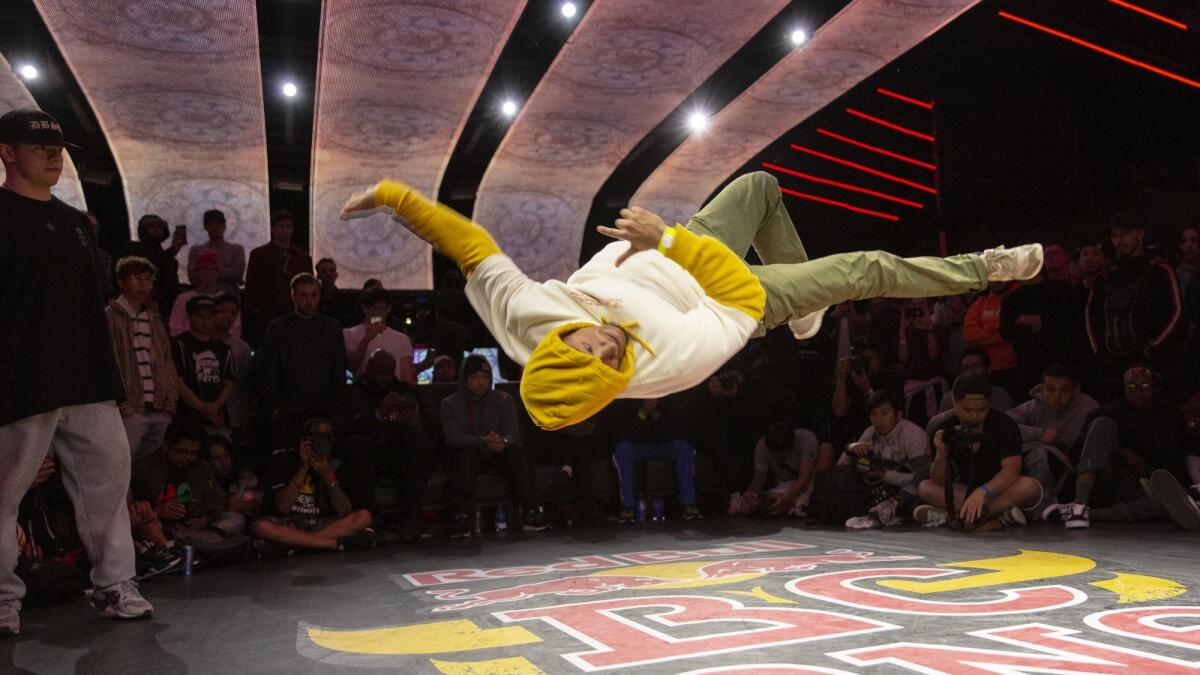Don’t call it breakdancing: ‘Breaking’ tries to bust into the Olympics

Earlier this year, organizers of the 2024 Summer Olympics in Paris proposed adding breaking to their program. Ryan Porter, a b-boy who has been dancing since middle school, competed recently in the Red Bull BC One All Star Tour.
A thudding beat fills the nightclub, music so loud it rattles your bones. Emerging from the crowd, a guy in white sneakers and a bright yellow hoodie skitters onto the empty dance floor.
With plenty of room to move, he drops suddenly, catching himself on one hand and kicking his legs in the air. The next thing you know, he flips upside-down, spinning on his head.
“I’m a little bit anxious,” he says later. “When I get like that, I’m making it up as I go.”
The nerves get to him because this b-boy named Yuri isn’t just breakdancing. He has reached the final of a regional qualifier with a spot in the national championships at stake.
“Freakin’ crazy,” he says.
To the dancers who competed in the recent Red Bull BC One contest in Hollywood — and hundreds of fans who came to watch — “breaking,” as it is correctly known, is no less athletic than gymnastics or figure skating.
Through round after round of one-on-one “battles,” competitors must execute basic footwork and perform the sort of power moves and airborne tricks that score extra points. Judges watch from the side, scribbling notes, scrutinizing each nuance.
Outsiders might scoff, but the International Olympic Committee has recognized breaking as a high-level competitive sport with a network of contests held worldwide. Earlier this year, organizers of the 2024 Summer Games in Paris proposed adding it to their program, citing an “unmissable opportunity” to attract young fans.
The possibility causes Yuri to grin, thinking about validation in the form of gold medals and television coverage. The 28-year-old from Brazil says: “Maybe a lot of people are going to look at us in a better way.”
::

Go back to the early days, to the streets of New York City in the 1970s.
Deejays extracted the instrumental “break” sections from the middle of funk or hip-hop songs and looped them together — tons of backbeat — to fuel a new culture with its own rules, fashion and language. You could call it performance art, but there was a competitive edge as onlookers circled around in “cyphers,” watching dancers try to outdo each other.
Breaking eventually seeped into the mainstream by way of movies and television — even the “Mighty Morphin Power Rangers” started flashing moves.
That was how Ryan Porter got exposed as a kid. He and some friends decided to give it a try.
“They could do it right away,” he recalls. “I played lots of sports — basketball, football, soccer, tennis — and I thought ‘This is ridiculous’ because I was the most athletic one of them but I couldn’t do the moves.”
In an age before YouTube, Porter downloaded videos from file-sharing sites and joined a gymnastics team, he says, “for the sole purpose of learning to do flips.” He gradually acquired the fundamentals.
Routines usually begin with top rock, a series of steps meant to show attitude and a sense of rhythm. Competitors then drop down to the all-important footwork, hovering inches above the floor, supported by hands and feet in rapid motion.
The power moves are more acrobatic, all those flips and spins requiring upper-body strength. Each series of tricks is punctuated by a freeze, a sudden pause, often in twisted or inverted position, to emphasize a beat in the music.
“Even when you’re not practicing, you’re thinking about it,” Porter says. “You might see somebody walk around or do something goofy and you’re like, ‘Yo, I can turn that into a move.’ ”
One more thing about breaking appeals to him — the distinct, in-your-face rivalry of one-on-one battles.
Built tall and lean with wire-rim glasses, the 27-year-old shows up early to the Red Bull BC One, stepping inside a hall illuminated by flickering LED panels that span the length of the ceiling.
Among the few breakers who perform under their given name, Porter spends the next few hours visiting with friends and warming up. When officials post the bracket, pitting him against a previous champion named Ali, he tugs a black do-rag over his head.
“Hardest battle in the Top 16,” he says. “He was the guy I wanted.”
A crowd gathers, with some people on tip-toes to see from farther back, as the battle begins. Porter directs a few early moves at Ali, pointing and kicking toward his foe, who paces at the edge of the floor. Ali shakes his head, responding with hand signals that every breaker understands.
If your opponent stumbles or “crashes” on a move, you bend down and slap the floor. If he dances slightly off the beat, you tap your ear.
This hip-hop form of trash talk continues between Porter and Ali for several minutes as they take turns performing routines of 30-40 seconds each.
“It got me going,” Porter says. “We were in a great battle.”
::

The news out of Paris took Mark Dyreson by surprise. Breaking in the Summer Games? It seemed insane to the Penn State professor who studies Olympic history.
“Then,” he says, “I thought about synchronized swimming.”
The IOC has a history of adding unconventional events in an effort to stay relevant and attract a young demographic.
Snowboarding, freestyle skiing and beach volleyball have become fan favorites. Others — synchronized swimming, trampoline and BMX cycling — have yet to draw big audiences.
“We all have our definition of how far is too far,” Dyreson says.
Still, additions have become more common in the wake of recent IOC reforms that allow host cities to include — on a one-time basis — one or more events of their choosing. Paris 2024 organizers nominated breaking because of its popularity in France; they describe it as a “quintessentially urban sport” that is “cheap and accessible” and enjoys worldwide “popularity among young people.”
Like video game players, b-boys and b-girls — the “b” stands for break, by most accounts — usually perform under pseudonyms. They concoct names such as RoxRite, Cheerito, Hi Jack and Lil Zoo based on personality or approach to dancing. Like snowboarders, they embody a distinct style.
Sign up for our daily sports newsletter »
The music ranges from James Brown to Run-DMC to Afrika Bambaataa and the fashion leans toward streetwear, with loose-fitting pants, sneakers for traction and windbreakers for spinning across the floor on your shoulder or back.
In the Olympic world, this kind of pop culture has commercial and sponsorship potential. It also helps that breaking connects, however tenuously, to traditional sport.
Over the years, b-boys and b-girls have borrowed generously from gymnastics. They took a pommel horse maneuver known as the Thomas Flair — hands down, legs swirling to the ceiling — and turned it into a dance move. When they added a mid-air spin, gymnastics borrowed it right back.
“You take something and make it even more difficult,” says Neguin, a b-boy champion who served as a judge at the Red Bull BC One. “Gymnastics looked at us and said, ‘We’re going to start using that.’”
Breaking got a test-run at the 2018 Youth Summer Olympics Games in Buenos Aires, where judges scored routines for technique, variety, musicality and personality. An array of countries — Canada, France, Japan, Russia — came away with medals, satisfying the IOC’s desire for global relevance.
DJ Lean Rock, a veteran breaker and deejay, supplied music for the competition and was impressed.
“It was the first time in an Olympic setting, so I wasn’t sure how it would go,” he says. “It worked really well.”

::
The crowd arrives at noon, lingering in the parking lot before drifting inside. Competition isn’t the only attraction at the Red Bull BC One — throughout the day, cyphers erupt spontaneously on the periphery of the dance floor.
A group gathers in the corner or near the bar and someone inevitably starts breaking. This free-form ambiance has always appealed to a young b-girl named Pebblz.
“Just the raw, dope energy,” she says. “I want to be part of the community.”
It is a big day for the 16-year-old who has traveled from San Diego. Dressed in a dark jacket and white sweatpants, she scores an upset win over Crissy B in the first round and advances to face Wonda, a veteran she has grown up watching.
“It’s like, whoa,” Pebblz says. “I started thinking about it … sometimes you have to check yourself.”
Competitive breaking requires a blend of strategy, instinct and poise. A dancer might begin with a plan, but must be ready to adapt on the fly.
If your opponent stumbles on a freeze or a flare, you can add that element on your next turn and impress the judges by getting it right. If your opponent executes a dazzling set of tricks, you had better respond.
Porter faces that sort of pressure against Ali, who ups the ante with a series of power moves near the end of a battle that has fans cheering. The final seconds are crucial.
“I was so focused on answering that I blanked on other stuff I needed to do,” Porter says. “I ended up repeating toward the end.”
His lapse proves decisive, with judges awarding the battle to his opponent. Frustrated, Porter retreats behind the stage and can’t help performing a few of the moves he should have done in the first place.
“Anytime you lose, you’re disappointed,” he says. “But I have to keep the energy going because we have another big competition in June, down in San Diego.”
That contest will coincide with an IOC session in Switzerland where members will vote on breaking and Paris’ three other proposed sports — surfing, skateboarding and sport climbing — with a simple majority required.
The newcomers that receive approval are guaranteed one shot to make an impression in hopes of permanent inclusion. Paris 2024 president Tony Estanguet says: “We believe these four sports are an opportunity to bring new audiences to the Olympic Games.”
The demographic that shows up for the Red Bull BC One in Los Angeles — host of the 2028 Summer Games — is young and devoted, staying for almost seven hours of competition.
Fans watch Pebblz get past Wonda, then defeat Feenx in the final of the b-girl’s bracket. This unexpected result earns the teenager a chance to compete for the national championship in Houston later this spring.
The b-boy’s final comes down to the last moments as Yuri finishes against Nico Spins with a burst of footwork, then hops to his feet, twirls and grabs his crotch. The judges raise his hand as the winner.
“I didn’t expect this,” he says.
His words emerge rapid-fire, punctuated by laughter. Though some breakers worry about organized sport corrupting their street-borne culture, he takes an optimistic view.
“Dudes flipping and spinning … it’s not like ballet,” he says. “It is literally a gangster dance, a dance from the poor places.”
Gold medals and television coverage might show the world a different side of what he fell “mad in love” with as a kid growing up in the capital city of Brasilia. Talk of the Olympics gets him excited.
“Serious crazy dope,” he says. “Can you imagine?”

Follow @LAtimesWharton on Twitter











